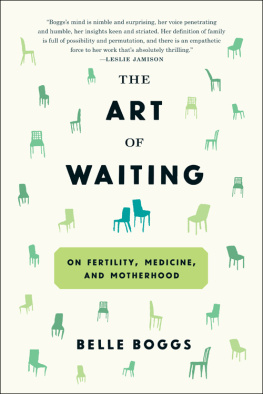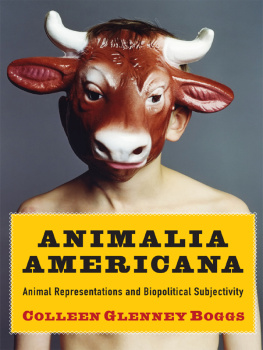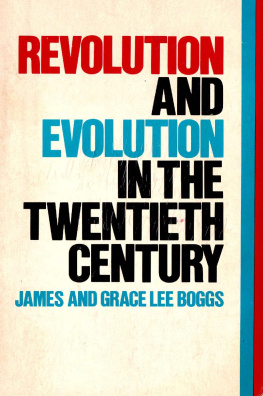The Art of Waiting
ON FERTILITY, MEDICINE,
AND MOTHERHOOD
Belle Boggs
Graywolf Press
Copyright 2016 by Belle Boggs
The author and Graywolf Press have provided this e-book to you for your personal use only. You may not make this e-book publicly available in any way. Copyright infringement is against the law. If you believe the copy of this e-book you are reading infringes on the authors copyright, please notify Graywolf Press at: us.macmillanusa.com/piracy.
This publication is made possible, in part, by the voters of Minnesota through a Minnesota State Arts Board Operating Support grant, thanks to a legislative appropriation from the arts and cultural heritage fund, and through a grant from the Wells Fargo Foundation Minnesota. Significant support has also been provided by Target, the McKnight Foundation, the Amazon Literary Partnership, and other generous contributions from foundations, corporations, and individuals. To these organizations and individuals we offer our heartfelt thanks.

Published by Graywolf Press
250 Third Avenue North, Suite 600
Minneapolis, Minnesota 55401
All rights reserved.
www.graywolfpress.org
Published in the United States of America
ISBN 978-1-55597-749-8
Ebook ISBN 978-1-55597-945-4
2 4 6 8 9 7 5 3 1
First Graywolf Printing, 2016
Library of Congress Control Number: 2016931135
Cover design: Kimberly Glyder Design
For my family
THE ART OF WAITING
The Art of Waiting
Its spring when I realize that I may never have children, and around that time the thirteen-year cicadas return, tunneling out of neat, round holes in the ground to shed their larval shells, sprout wings, and fly to the treetops, filling the air with the sound of their singular purpose: reproduction. In the woods where I live, an area mostly protected from habitat destruction, the males mating song, a vibrating, whooshing, endless hum, a sound at once faraway and up close, makes me feel as though I am living inside a seashell.
Near the river, where the cicadas song is louder, their discarded larval shellstranslucent amber bodies, weightless and eeriecrunch underfoot on my daily walks. Across the river, in a nest constructed near the top of a tall, spindly pine, bald eagles take turns caring for two new eaglets. Turtle hatchlings, snakelets, and ducklings appear on the water. Under my parents porch, three feral cats give birth in quick succession. And on the news, a miracle pregnancy: Jamani, an eleven-year-old female gorilla, is expecting, the first gorilla pregnancy at the North Carolina Zoo in twenty-two years.
I visit my reproductive endocrinologists office in May and notice, in the air surrounding the concrete-and-steel hospital complex, a strange absence of sound. There are no tall trees to catch the wind or harbor the cicadas, and on the pedestrian bridge from the parking deck, everyone walks quickly, head down, intent on making their appointments. In the waiting room, I test the leaf surface of a potted ficus with my fingernail and am reassured to find that it is real: green, living.
The waiting rooms magazine selection is scanty: a couple of years-old New Yorker s, the address labels torn off, and a thick volume of the alarmingly titled Fertility and Sterility . On the journals cover is a small, square photograph of an infant rhesus monkey clasped by an unseen humans hands in a white terry-cloth towel. The monkey wears a startled expression, its dark eyes wide, its mouth forming a tiny pink oval of surprise. A baby monkey hardly seems the thing to put in front of women struggling through the confusion and uncertainties of fertility treatment What are those mysterious, grayish blobs on the ultrasound, anyway? but, unsure how long Ill wait before my name is called, I reach for the journal. Flipping through, I find another photograph of the monkey and its monkey siblings, and the corresponding article about fertility preservation in human and nonhuman primates exposed to radiation. This monkeys mother, along with twenty other monkeys, was given an experimental drug and exposed to the same kind of radiation administered to women undergoing cancer treatment. On other pages, I find research about mouse testicular cells, peritoneal adhesions in rats, and in vitro fertilization of baboons.
Of course, this research was designed to study human, not animal, infertility. Nonhuman animals dont expose themselves to fertility-compromising radiation therapy; nor do they postpone reproduction, as I have, with years of birth control. Reproducing and ensuring the sexual maturity of offspring is a biological imperative for animalstheir success depends on it, and in species after species we see that both males and females will sacrifice everything, their lives, even, to achieve it. But in species with more complex reproductive systemsthe animals genetically closest to humansscientists have documented examples of infertility, hormonal imbalances, endometriosis, and reproductive suppression. How do they cope? I wonder, staring at the photo of the baby rhesus monkey, its round, wide-set eyes designed to provoke a maternal response. Do they deal with infertility or the inability to become parents any betteror any differentlythan we do?
My name is called, and a doctor Ive never met performs a scan of my ovaries. I take notes in a blank book Ive filled with four-leaf clovers found on my river walks: Two follicles? Three? Chance of success 15 to 18 percent .
On the way out, I steal the journal with the monkey on the cover. Back home, under the canopy of oak and hickory trees, I open the car door, and sound rushes in, louder after its absence. Cicadasongthousands and thousands of males contracting their internal membranes so that each might find his mate. In Tennessee it gets so bad that a man calls 911 to complain because he thinks its someone operating machinery.
A few days later, I visit the North Carolina Zoo, where Jamani, the pregnant gorilla, seems unaware of the dozens of extra visitors who have come to see her each day since the announcement of her condition. She shares an enclosure with Acacia, a socially dominant but relatively petite sixteen-year-old female, and Nkosi, a twenty-year-old, 410-pound male. The breeding of captive lowland gorillas is managed by a Species Survival Plan that aims to ensure genetic diversity among captive members of a species. That means adult female gorillas are given birth control pillsthe same kind humans takeuntil genetic testing recommends them for breeding with a male of the same species. Even after clearance, it can take months or years for captive gorillas to conceive. Some never do.
Humans have a long history of imposing various forms of birth control and reproductive technologies on animals, breeding some and sterilizing others. In recent years, weve administered advanced fertility treatments to endangered captive animals such as giant pandas and lowland gorillas. These measures, both high-and low-tech, have come to seem as routine as the management of our own reproduction. We feel responsible when we spay and neuter our cats and dogs, proud when our local zoos release photos of baby animals born of luck and science.
Jamani and Acacia were both brought to the North Carolina Zoo in 2010, after Jamani was recommended for breeding with Nkosi, which was accomplished simply by housing the animals in the same enclosure. The zoo staff confirmed Jamanis pregnancy through an e.p.t. pregnancy test, the kind you can buy at a drugstore.













